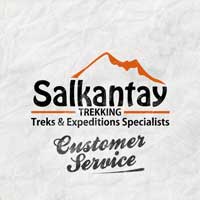THE ULTIMATE TREKKING PERU PACKING LIST TOUR GUIDES
You’ve decided to join us on an exciting trek through the Peruvian Andes!
We’re sure you’re excited and can’t wait to get on the trail. But first, you need to ensure you take everything you’ll need along the way. Well, you’re in luck…
We’ve put together the ultimate Trekking Peru packing list to help you prepare for your incredible outdoor adventure in one of the most stunning regions of South America.
Below, you’ll find detailed descriptions of every single piece of kit you need to enjoy a safe and successful trekking trip. These are our personal recommendations on gear that we own and use to trek comfortably time after time. We believe these recommended gear items provide the best value for money and deliver the best performance.
We’ve put together the ultimate Trekking Peru packing list to help you prepare for your incredible outdoor adventure in one of the most stunning regions of South America.
The Essential Packing List for Trekking in Peru
Duffle Bag and Backpack
Duffle Bag
The evening before you start your trek, we’ll give you a small duffle bag to pack your clothes and other items for the duration of the trek. You’re allowed up to 7 kg/15.4 lbs weight allowance.
Our horseman will carry your duffle bag for you, together with the food and camping gear, along the entire route. It’s important to note that you won’t have access to your items in the duffle bag until the end of each day at the campsites—the horsemen and horses will always be ahead of the group.
During the day, you need a backpack big enough to carry your personal belongings—a warm jacket, raincoat, camera, sunscreen, snacks, water, etc. A 30-liter backpack is usually sufficient.
Backpack
Along our routes, a porter or mule will usually be carrying your duffle bag or large rucksack. This means that you need to carry a lightweight daypack to carry essentials—snacks, water, a camera, sunscreen, etc.
We suggest a backpack with compression straps to reduce weight stress on your back and side mesh pockets for quick access to your water bottle. The Osprey Talon is our recommended backpack.
It’s important you bring a rain cover for your rucksack as you never know when there’ll be a downpour in the Andes. If you decide to use an Osprey backpack, then make sure you get an Osprey Raincover that matches the bag size for a snug fit.
Documents
Original Passport
Of course, you need your passport to get into Peru, but you’ll also need it when you embark on a trek. There’s an official government checkpoint at the start of the trail that works to enforce the strict limits on how many visitors can walk the trail daily, and every foreigner beginning a trek must show their passport.
In addition, if your trek is ending in Machu Picchu, you won’t be allowed into the site without it. Ensure your entrance tickets have the exact passport details on them, or this can also cause issues.
Clothing
Underwear
The first and most important layer is your underwear. To aid you in comfort with all the hiking, we recommend bringing 4–6 x pairs of breathable sports underwear.
We’re big fans of Icebreaker underwear, Adidas sports underwear, or Under Armour underwear, as these brands specifically focus on manufacturing products that can cope with sweat from high-intensity exercise and sports.
Base Layer
The base layer, or the next-to-skin or first layer, is extremely important on the higher parts of the Salkantay Trek where it can get very cold and sometimes below 0°C.
The best first layers fit snugly to the body (reducing air pockets and flow) and consist of high-wicking materials to facilitate moisture transfer.
We recommend getting 2 top and 1 bottom base layer to last you the first two days.
Trekking Shirts
You’ll need to bring 4–7 trekking shirts—depending on whether you’re doing a short or long trek). We recommend these breathable and lightweight shirts from Hanes. Alternatively, shirts from Icebreaker or Columbia are also of great quality.
Don’t bring cotton shirts as these absorb moisture and can lead to you feeling very uncomfortable. A mixture of short and long sleeve shirts is recommended for the differing climates.
Hard Shell Jacket and Rain Gear
Rain is always possible when trekking in Peru, particularly during the rainy season (October-March). You should bring a hard-shell jacket for ultimate protection when it’s wet, like the North Face Resolve Jacket.
It’s also worth taking a compact rain poncho that can quickly be put on should you encounter a light downpour—especially useful for the jungle.
Insulated Jacket
The outer or third layer, consists of a windproof, waterproof, and most importantly, warm jacket and trousers. These will be used on the upper sections of the Salkantay Trek where it gets very cold.
We highly recommend getting a high-quality jacket as it’s one of the few key items that’ll ensure your warmth and comfort along the route. We suggest the North Face Nuptse Jacket— which is a market-leading winter jacket—but there are many synthetic alternatives that are also effective.
In terms of the Nuptse, the warmth and weight characteristics are exceptional. The Nuptse is a lifetime investment as the jacket will last years of active trekking and double well as a winter jacket in the city. Other top jacket brands include Patagonia Down Jacket, Arc’Teryx Atom, and Mountain Hardwear Down Jackets.
Fleece Jacket
The second layer, or what we call the insulation layer, should be made from fleece material.
We recommend a Polartec 200 Fleece Jacket. These insulation jackets are extremely good for hiking as they provide a great warmth to weight ratio whilst allowing effective moisture transfer. The Polartec 100s are lighter but not warm enough for the Salkantay Trek, whereas the Polartec 300s are too heavy, in our opinion.
Recommended fleece brands included Helly Hansen, The North Face, and Patagonia.
Trekking Pants and Shorts
You’ll also need to pack hiking shorts and pants. There are many brands to choose from, but we recommend Craghoppers, Columbia, or O’Neills.
You can go with convertible pants like this trekking model designed by Craghoppers. Not only will they save you money as you won’t need to buy shorts, but they are also very comfortable.
Bring two pairs of pants and one pair of shorts.
Pajama Pants
Whether you use sweatpants or pajama pants, these are recommended for you to unwind in the campsites and get cozy in your bed. It gets chilly at night, so opt for warm, long pants.
Inner Gloves
An inner glove acts as your next-to-skin layer, like the base layer clothing we described above. You should bring a lightweight, quick-drying inner glove, ideally made from fleece material.
We recommend Pearl Izumi Thermal Lite Gloves, which can also be used as standalone gloves when the weather is moderately cold. Karrimor is another quality brand.
Outer Gloves
Outer gloves are like your outer layer jacket—they act as a shield from the cold and must be very warm, waterproof, and durable. Gore-Tex gloves from Dakine or similar options from The North Face, Outdoor Research, or Black Diamond are recommended.
Headgear
Hat for Sun Protection
You must bring a hiking hat that protects face and neck from the glaring sun. At high altitudes, it’s easy to get burnt in just a few minutes.
Your hat should be light and easy to bend/fold so that it can fit into your backpack or rucksack. Trekking hats with a neck cover are great to give you ultimate protection.
Head Band or Beanie
Temperatures can get very cold in the evenings and early mornings, particularly as you reach the higher altitudes on the Salkantay Trek or head out on the Ausangate trails.
A warm fleeced beanie or fleeced headband are absolute must-haves. Berghaus and The North Face provide some fantastic beanies for trekking in the cold.
Neck Gaiter or Balaclava
A neckband or balaclava that can keep your neck and face warm when temperatures drop below freezing is also a must-have.
We highly recommend taking one fleeced buff and one thin buff.
Buffs are super versatile and can be used as headbands, beanies, neck gaiters, and wrist bands, as demonstrated in the image.
Footwear
Hiking Boots
Good hiking boots are the most important piece of gear on your trek—your feet are what get you from the beginning to end of the Salkantay Trek!
Badly fitting hiking boots will result in damaged toenails, painful blisters, and all-around sore feet.
To find the best fit, put your foot in a boot without tying the shoelaces. Once in, slide your foot all the way forward until the toes hit the front of the boot. You should be able to put your index finger down the back of the boot between your heel. If your finger has lots of room to move then the shoe is too big, but if you struggle to get your index finger into the boot then the shoe is too small.
Here are some recommended and reliable brands of the best hiking boots: Scarpa, Salomon—we like the Quest range—Berghaus—we like the Explorer range—, Hi-Tec, and Karrimor.
Sneakers (Trekking Shoes/Sandals)
After a long day of hiking across rough terrain, the first thing you will want to do is to change into a comfortable pair of shoes. We recommend bringing trekking shoes, sneakers, or sandals. We like Merrel trekking shoes, and trekking sandals are great to wear with warm socks for optimum comfort.
Hiking Socks
You’ll need 5–6 pairs of hiking socks and 4–5 pairs of high-wicking sock liners.
We recommend Coolmax hiking socks as they provide excellent breathability and have fantastic wicking properties. Smartwool, Bridgedale, and Point 6 also make great socks.
Don’t bring cotton socks, as these will lead to nasty blisters and sweating.
Thermal Socks
Bring 1 or 2 pairs of thermal socks for the cold hiking days around the upper parts of the Salkantay Trek.
We recommend Smartwool thermal socks, as they are very warm, provide great cushioning for the foot, and have flat seams (bulky seams result in blisters).
Other good brands include Wigwam and Bridgedale.
Gaiters
Gaiters are made from waterproof material and extend up from your boot to the top of your calf.
Gaiters are used to stop water, dust, mud, snow, ice, and small stones from getting into your hiking boots.
Sleeping Bag
Sleeping Bag
For any of our treks, you’ll need to bring a warm sleeping bag, as the nights can get very cold—occasionally below 0°C.
The best types of sleeping bags are manufactured using a duck or goose down, but they also tend to be the most expensive. If you’re stretched for cash, a warm synthetic alternative is fine. Just make sure that it has a rating of at least -10°C.
Look out for a sleeping bag that has a mummy shape with an insulated hood and draw cord so that it fits the contours of your body. Two-way zippers for better insulation are great.
We recommend the following brands and models: The North Face Snow Leopard, Marmot Trestles, Mountain Hardwear Phantom Highlander, or Coleman.
Important Accessories
Trekking Poles
High-quality walking poles can reduce the impact on your knees and leg joints by up to 20 percent. Trekking poles are particularly useful when descending, as the load on your joints increases exponentially when going downhill.
We recommend getting light-weight (around 350 grams per pair) and adjustable trekking poles, as they are easy to store and very versatile. Black Diamond walking poles are excellent, as are Leki poles.
Sunglasses
The UV intensity in Cusco, Peru, is very high due to the high altitude and glare from the snowy mountain peaks.
You should bring a quality pair of UV protection sunglasses (minimum of 80% light reduction). We recommend mountain sunglasses from Julbo.
Flashlight or Headlamp
You won’t be hiking at night, but you might need to go to the toilet in the dark or want to read before bed. Many of the teahouses and campsites are poorly lit or have no electricity at all, so extra lighting is very helpful.
Petzl Tikka is the best headlamp brand. Don’t forget to bring spare batteries as well.
Water Bottle or Hydration Bladder
Many people suffer from dehydration at high altitudes. You should aim to drink 2–3 liters of water a day. Heatstroke and dizziness are common for dehydrated trekkers and could cause you to miss out on the rest of your hike.
Water can be carried in a standard water bottle—we recommend getting 2 x 1L CamelBak Water Bottles.
Or, if your daypack includes space for a hydration bladder, then the 2L Platypus Hydration Bladder is an excellent product.
Camera
The scenery in Cusco, Peru, is amazing! You’ll definitely want to capture your experience in HD, so if you don’t have a decent camera, now’s the time to get one.
Here are some recommended and affordable Digital SLR cameras. Remember, you want to make sure your camera is light but still able to capture high-quality images. We like the Panasonic Lumex. If you’re more inclined to take videos, then you might want to consider the GoPro.
Notebook/Journal & Pen
This isn’t a must but is a great way to chronicle your trek so you remember every last detail.
Personal Gear and Medication
-
Swimsuit:
If you plan on taking a dip in Aguas Calientes hot springs, this is a must. On some routes, there are also opportunities to swim.
-
Trekking Towel:
A small to medium-sized hiking towel can come in very handy. LifeVentures or Discovery provide good, quick-drying trekking towels.
-
Cash
Along the route, there are spots to buy snacks and water. It’s also a great idea to have extra cash (S/300–S/400) in case of an emergency.
-
Toilet Paper
You might need to go to the bathroom during the day. You’ll need toilet paper as most toilets don’t usually provide this.
-
Portable Power Pack
Although there are opportunities to charge devices on some treks, a portable power is a great idea so you can charge anytime, anywhere.
-
Small Locks
To protect your belongings in your rucksack or duffle bag.
-
Waterproof Ziplock Bags
These come in handy for storing important/valuable items like your money, passport, and electrical equipment.
-
Isotonic Powder
Can be used to flavor your water and helps replace electrolytes, improving energy levels and aiding water absorption.
-
Diamox
Also know as acetazolamide, this is a medication that can be used as a prophylactic (preventative) solution for altitude sickness. It does not cure altitude sickness and should never, therefore, be used as a method to continue ascending to high altitudes. It can, however, help prevent the onset of altitude sickness and is commonly used by high altitude climbers and trekkers.
-
General Medications
We recommend taking paracetamol or aspirin for headaches (a common altitude sickness symptom on the Salkantay Trek) and Immodium for diarrhea.
-
Basic First Aid Kit
If you’re joining an organized trek, your guide will most likely be carrying a first aid kit. If you’re hiking unsupported or independently then a first aid kit is a must.
-
Sunscreen/Lip balm
No one wants burnt skin or cracked lips. Be sure to bring 1 x sunscreen (SPF 50+) and 1 x lip balm.
-
Bug Spray/Repellent
As you get closer and closer to Machu Picchu, you’ll come across more bugs that like to bite! You’ll need this to keep them away.
-
Baby Wipes/Body Wipes
For quick and easy wet washes when no showers are in sight! Bring 1 x baby wipes or body wipes.
-
Blister Plasters
The dreaded blisters! We recommend taking Compeed blister plasters
-
Hand Sanitizer
Great for disinfecting hands before and after eating, or when they get dirty during the hike.
What to Pack in Your Backpack
We’ve already mentioned the importance of having a lightweight, quality backpack to carry the necessities in during the day. However, you might still be wondering what needs to go in there and what to put in your duffle bag. Fear not! We’ve compiled a checklist of everything that needs to go in your daypack.
- Rain jacket/poncho
- Fleece
- Sunhat/beanie
- Water bottle
- Bug spray
- Sunscreen
- Personal medication
- Toilet paper
- Cash
- Passport
- Camera
Packing List By Region
To help you be the best prepared you can be, we’ve put together specific packing lists for different treks. This way, you won’t take anything unnecessary or forget an essential item.
To Machu Picchu
Without a doubt, the most popular place to go trekking is on one of the routes to Machu Picchu. On these treks, you’ll tend to pass through high and very cold mountainous regions before descending into warmer rainforests.
You’ll need to take lots of things with you to be prepared for all kinds of weather and climates. The items below are based on the most common 4–5 day treks, but you can change it according to your trip if it’ll be more or less days.
Here’s our ultimate checklist to pack for Machu Picchu.
- Duffle bag (we provide this)
- Back pack
- Original passport
- 4–6 pairs of underwear
- 5–6 pairs of hiking socks
- 1–2 pairs of thermal socks
- 4–5 high wicking sock liners
- 2 x top base layers
- 1 x bottom base layer
- 5–6 trekking shirts
- Hard shell jacket
- Rain jacket or poncho
- Insulated jacket
- Fleece jacket
- Sweater
- 2 x trekking pants
- 1 x shorts
- Pajamas
- Sunhat
- Sunglasses
- Head band or beanie
- Neck gaiter
- Inner and outer gloves
- Hiking boots
- Trekking shoes/sneakers/sandals
- Gaiters
- Swimsuit
- Sleeping bag (can rent from us)
- Walking poles (can rent from us)
- Headlamp/flashlight
- Water bottle or hydration bladder
- Camera
- Notebook/journal
- Trekking towel
- Small locks
- Waterproof ziplock bags
- Isotonic powder
- Diamox
- General medications
- Basic first aid kit
- Sunscreen (SPF 50+)
- Bug spray
- Lip balm
- Baby wipes/body wipes
- Blister plasters
- Hand sanitizer
- Toilet paper
- Portable power pack
- Cash
To the Mountains
Another frequent hiking region is high up in the mountains. Ausangate is one of the most popular treks in this part of Peru. You’ll find the weather can get very cold as you spend a lot of time walking among the glaciers.
You’ll mainly be needing warm clothing for these treks and can do without some of the items on the previous list. Again, you can change the amount fof items depending on the length of the trek.
Here’s our checklist if you’re traveling to the colder mountain regions of Peru:
- Duffle bag (we provide this)
- Back pack
- Original passport
- 4–6 pairs of underwear
- 5–6 pairs of hiking socks
- 1–2 pairs of thermal socks
- 4–5 high wicking sock liners
- 2 x top base layers
- 1 x bottom base layer
- 5–6 trekking shirts
- Hard shell jacket
- Rain jacket or poncho
- Insulated jacket
- Fleece jacket
- Sweater
- 2 x trekking pants
- Pajamas
- Sunhat
- Sunglasses
- Head band or beanie
- Neck gaiter
- Inner and outer gloves
- Hiking boots
- Trekking shoes/sneakers/sandals
- Gaiters
- Sleeping bag (can rent from us)
- Walking poles (can rent from us)
- Headlamp/flashlight
- Water bottle or hydration bladder
- Camera
- Notebook/journal
- Trekking towel
- Small locks
- Waterproof ziplock bags
- Isotonic powder
- Diamox
- General medications
- Basic first aid kit
- Sunscreen (SPF 50+)
- Lip balm
- Baby wipes/body wipes
- Blister plasters
- Hand sanitizer
- Toilet paper
- Portable power pack
- Cash
To the Andes
When it comes to hiking in the Andes, these are usually shorter treks and don’t go quite as high up as the colder mountain regions. This includes hikes like the Huchuy Qosqo trek. The days will usually be warm and sunny but the evening a little colder.
You won’t need quite as many warm items as on our previous two lists. Here’s our essential Andean trekking packing list:
- Duffle bag (we provide this)
- Back pack
- Original passport
- 4–6 pairs of underwear
- 5–6 pairs of hiking socks
- 4–5 high wicking sock liners
- 5–6 trekking shirts
- Rain jacket or poncho
- Insulated jacket
- Fleece jacket
- Sweater
- 2 x trekking pants
- 1 x shorts
- Pajamas
- Sunhat
- Sunglasses
- Head band or beanie
- Neck gaiter
- outer gloves
- Hiking boots
- Trekking shoes/sneakers/sandals
- Gaiters
- Sleeping bag (can rent from us)
- Walking poles (can rent from us)
- Headlamp/flashlight
- Water bottle or hydration bladder
- Camera
- Notebook/journal
- Trekking towel
- Small locks
- Waterproof ziplock bags
- Isotonic powder
- Diamox
- General medications
- Basic first aid kit
- Sunscreen (SPF 50+)
- Lip balm
- Baby wipes/body wipes
- Blister plasters
- Hand sanitizer
- Toilet paper
- Portable power pack
- Cash
To the Jungle
Trips to the jungle, especially Tarapoto and Manu, are very popular with visitors to Peru. The climate is warm and humid, and rain is sometimes even welcome. You’ll be hiking through unique flora and fauna and spotting some rare species.
You won’t need extra warm clothes at all here. However, some relatively warm clothing is needed at night, especially during the colder months. You’ll also find there are lots of bugs around, and will need to protect yourself from them.
Here’s our ultimate jungle packing list:
- Duffle bag (we provide this)
- Back pack
- Original passport
- 4–6 pairs of underwear
- 5–6 pairs of hiking socks
- 1–2 pairs of thermal socks
- 4–5 high wicking sock liners
- 2 x top base layers
- 1 x bottom base layer
- 5–6 trekking shirts
- Hard shell jacket
- Rain jacket or poncho
- Insulated jacket
- Fleece jacket
- Sweater
- 2 x trekking pants
- Pajamas
- Sunhat
- Sunglasses
- Head band or beanie
- Neck gaiter
- Inner and outer gloves
- Hiking boots
- Trekking shoes/sneakers/sandals
- Gaiters
- Sleeping bag (can rent from us)
- Walking poles (can rent from us)
- Headlamp/flashlight
- Water bottle or hydration bladder
- Camera
- Notebook/journal
- Trekking towel
- Small locks
- Waterproof ziplock bags
- Isotonic powder
- Diamox
- General medications
- Basic first aid kit
- Sunscreen (SPF 50+)
- Lip balm
- Baby wipes/body wipes
- Blister plasters
- Hand sanitizer
- Toilet paper
- Portable power pack
- Cash
Find the Perfect Destination in Peru
With astonishingly varied landscapes, stunning scenery, compelling history, and a legacy of fascinating cultures, there is truly something for everyone. Our expeditions in Peru are designed to showcase all that this country has to offer.
Our expeditions in Peru are designed to showcase all that this country has to offer.











